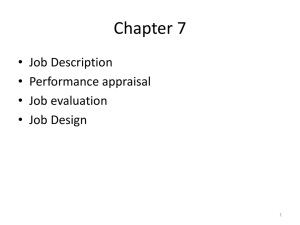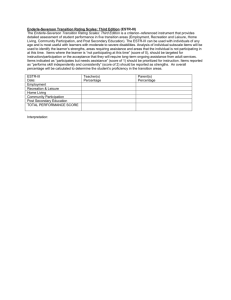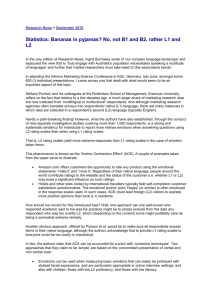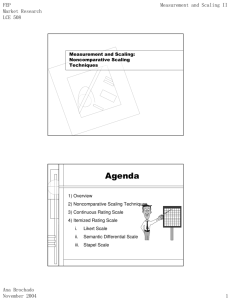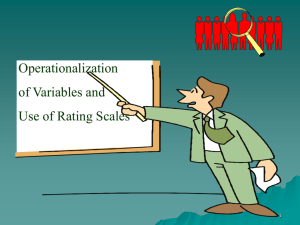Getting Started on Using Environment Rating Scales through
advertisement
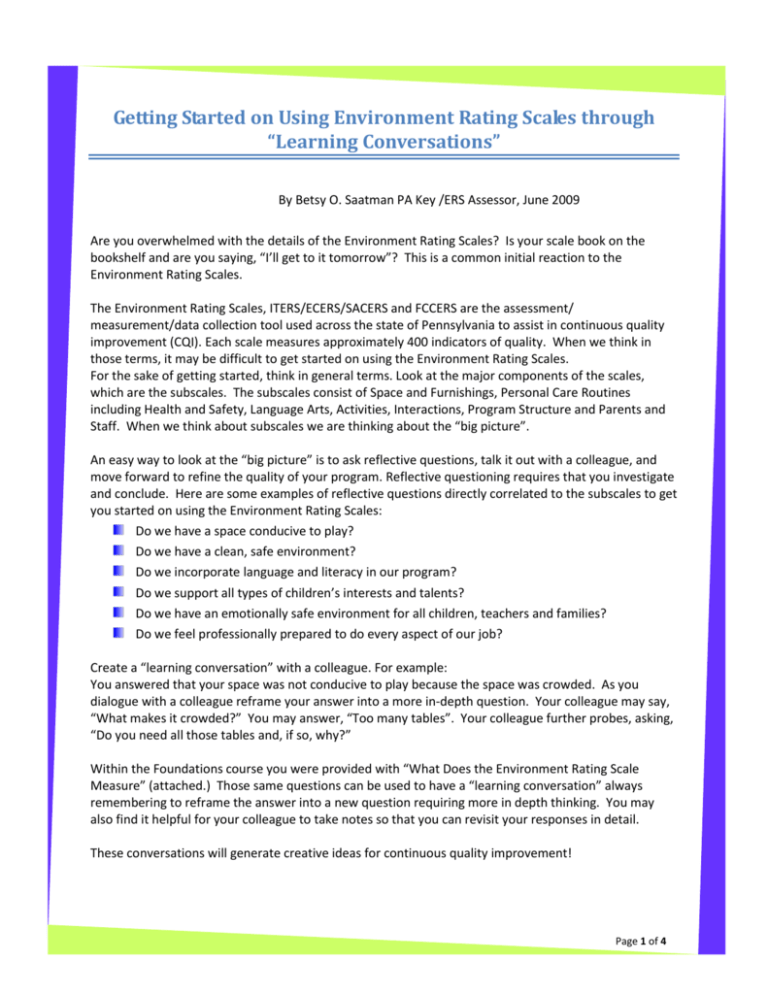
Getting Started on Using Environment Rating Scales through “Learning Conversations” By Betsy O. Saatman PA Key /ERS Assessor, June 2009 Are you overwhelmed with the details of the Environment Rating Scales? Is your scale book on the bookshelf and are you saying, “I’ll get to it tomorrow”? This is a common initial reaction to the Environment Rating Scales. The Environment Rating Scales, ITERS/ECERS/SACERS and FCCERS are the assessment/ measurement/data collection tool used across the state of Pennsylvania to assist in continuous quality improvement (CQI). Each scale measures approximately 400 indicators of quality. When we think in those terms, it may be difficult to get started on using the Environment Rating Scales. For the sake of getting started, think in general terms. Look at the major components of the scales, which are the subscales. The subscales consist of Space and Furnishings, Personal Care Routines including Health and Safety, Language Arts, Activities, Interactions, Program Structure and Parents and Staff. When we think about subscales we are thinking about the “big picture”. An easy way to look at the “big picture” is to ask reflective questions, talk it out with a colleague, and move forward to refine the quality of your program. Reflective questioning requires that you investigate and conclude. Here are some examples of reflective questions directly correlated to the subscales to get you started on using the Environment Rating Scales: Do we have a space conducive to play? Do we have a clean, safe environment? Do we incorporate language and literacy in our program? Do we support all types of children’s interests and talents? Do we have an emotionally safe environment for all children, teachers and families? Do we feel professionally prepared to do every aspect of our job? Create a “learning conversation” with a colleague. For example: You answered that your space was not conducive to play because the space was crowded. As you dialogue with a colleague reframe your answer into a more in-depth question. Your colleague may say, “What makes it crowded?” You may answer, “Too many tables”. Your colleague further probes, asking, “Do you need all those tables and, if so, why?” Within the Foundations course you were provided with “What Does the Environment Rating Scale Measure” (attached.) Those same questions can be used to have a “learning conversation” always remembering to reframe the answer into a new question requiring more in depth thinking. You may also find it helpful for your colleague to take notes so that you can revisit your responses in detail. These conversations will generate creative ideas for continuous quality improvement! Pennsylvania Keys to Quality (2013) Page 1 of 4 What Does the Environment Rating Scale Measure? SCHEDULE Children have opportunities to explore and engage in many different ways which respects their differences. Cognitive Emotional Physical Individual Interests Ask yourself: Do we take all of these things in to account when we create the schedule? Do we follow the same schedule of events daily (with some flexibility) so that children know what the routine is and what they can expect next? Do we pick a theme and then add some activities related to the theme, or do we start with a curriculum that is based on clearly defined child outcomes and create a schedule and activities that partners with the curriculum? Keep In Mind: The Schedule needs consistency for emotional safety and requires intentional planning, yet remains flexible for changes as needed. INTERACTIONS Types of interactions include Staff to child, child to child, parent to staff, and staff to staff Implications: Positive Negative Neutral Purposeful and Social Ask yourself: How often do we talk individually with each child? How often do we greet the parents, and talk with them for extended periods of time, what do we talk about? Do I talk with my colleagues through out the day? What is our tone of voice like when we interact? What does our body language look like? Do we feel good about the frequency of our interactions and the types we are having? Keep In Mind: Interactions have their own subscale and are interwoven throughout the items. Pennsylvania Early Learning Keys to Quality (2013) Page 2 of 4 What Does the Environment Rating Scale Measure? ACCESSIBILITY OF MATERIALS Ask yourself: Do children know what we have to play with? Can they see it? Can children reach the materials, and can they get them out of storage to play with them? Can the children easily clean up and know where to put the materials away? Are the materials accessible for the children for enough time during the day? Keep In Mind: Materials need to be accessible; children can easily get them, and be accessible to children for a designated period of time. (See each individual age group scale for more detail.) SPACE MANAGEMENT Provides the ability to move freely Analyzes traffic patterns Place centers conveniently Quiet and noisy centers separate Places for children to be alone Supervision is easy Ask yourself: Does every child seem engaged in something? Are children able to move around the room without bumping into things and people? Is there excessive running from place to place? Does the child have what he needs close by? Is the noise level in each area appropriate, are children who need it quiet able to concentrate? Can children find a place to be alone and protected from others as needed? Are there any spaces in my classroom where I may not know what children are doing? Keep In Mind: Children need an environment set up for success; to have the freedom to move about and not interrupt others play. The environment should have centers placed out of traffic and equipped with the materials needed (with this, classrooms need to be ever-changing- make modifications in centers and materials). Children need to concentrate as they work/play. The environment should be set up so that noise is not distracting the learning that is occurring. At times children need a break just like adults, the room should be set up to accept and promote children’s needs to be alone. Classrooms should always be set up so that they are easy to supervise at a glance. Pennsylvania Early Learning Keys to Quality (2013) Page 3 of 4 What Does the Environment Rating Scale Measure? HEALTH AND SAFETY Cleanliness, hand washing, sanitizing, safe equipment, and safe environment Ask yourself: Is our facility clean, would I be willing to sit on the floor? Do the children know when to wash their hands? Why do we sanitize, what should we sanitize, how do we sanitize? When was the last playground safety analysis done? Does my environment have any safety certification violations? Keep In Mind: Prevention is the best measure. Proper practices need to become habitual. COMBINATION OF ALL How children interact with space and materials. Ask yourself: Are the children having fun? Are they using the materials? Is the space set up for success? Keep In Mind: The scale looks at what the children are doing, what is available to them and does the environment encourage individual success? Pennsylvania Early Learning Keys to Quality (2013) Page 4 of 4
